Report from the Electronic Standards Institute of the Ministry of Industry and Information Technology: Blockchain standardization helps digital economic development
Author: Li Ming, China Electronics Standardization Institute Block Chaining Research Office;
Li Jiazheng, Standards Development Engineer, China Electronics Standardization Institute;
Sun Lin, Standard Development Engineer, China National Institute of Electronic Standardization.
Core points
- QKL123 data analysis | Bitcoin's energy consumption is amazing, and its energy consumption valuation exceeds 10,000 USD / BTC
- MOV Product Design
- BitMEX: Inflation is coming, Bitcoin may usher in the greatest opportunity
With the rapid development of blockchain technology, more organizations recognize the value of blockchain technology. This article introduces domestic and international blockchain standards organizations and standards development results, describes the blockchain industry in terms of technology, platform, and application, and gives suggestions for further work through analysis and summary. At the same time, it also analyzes and discusses from the aspects of system engineering, technology fusion, component iteration, and target system, and has made meaningful thinking and exploration for the development of the blockchain industry.
The application of blockchain technology has just begun. It should not be deified and demonized. It should actively strengthen the development of various standards and guide the development of application practices through standards. In practice, we must not only make breakthroughs in key technologies such as cross-chain, componentization, and distributed storage, but also explore applications in certificate storage, traceability, and data exchange, while also meeting regulatory requirements.
Blockchain technology is an important puzzle of the digital economy. From a larger system perspective, data will quantify everything, and we are gradually entering the digital world. Phenomenon of wisdom, emergence and mimicry are gradually discovered, analyzed and used, which will change the traditional cognitive model and lifestyle.
Data and the digital economy
Pythagoras believes that numbers are the foundation of everything. Data can be recognized through four aspects: ontology, practice, cognition and value (see Figure 1-2). From the perspective of ontology, data is a logical induction of objective things, and raw raw materials used to represent objective things. From a practical perspective, data can be roughly divided into four processes: acquisition, storage, utilization and disposal.
From a cognitive perspective, data can be transformed into information, which can then refine knowledge. Both the practice and understanding of these processes require technology / devices to complete. From a value perspective, data can be an asset and can generate data-based services and businesses.
Data is always there. It ’s just that we did n’t have the corresponding technology / device to acquire and use the data initially. Therefore, big data is only a specific stage of data development. After the development of data to the big data stage, more new technical devices such as big data and cloud computing are needed to process and utilize huge data resources.
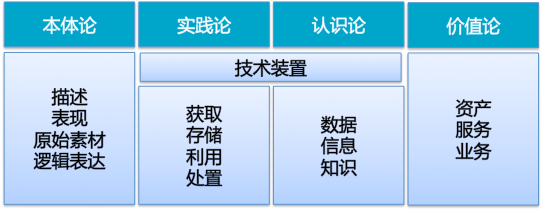
Figure 1-2 Multidimensional thinking of data
With the rapid development of new-generation information technologies such as blockchain, the value of data has been agreed, and the digital economy has become an important direction for global competition. The nature of the digital economy is determined by the nature of the data.
First, the marginal cost of data utilization decreases. Once collected, the data can be used unlimitedly (here, from the perspective of data only, the issue of compliance and usage agreements is not considered). Second, the value space of data can be infinitely enlarged. Each valuable data item and other data items can be combined into a new value data item, thereby serving more applications and generating more valuable data. Finally, data-driven services have become the mainstream Internet service form. Data-based service business models have overturned traditional product models and accelerated the transformation of traditional product forms into service forms.
However, in the process of using information technology to obtain data value, there are many problems such as data security and data consistency. Low-quality data will severely hinder the development of the digital economy. Therefore, the trusted, consensus, and tamper-resistant technical characteristics of blockchain technology are required to provide high-quality data and accelerate the development of the digital economy.
Domestic standard
National Blockchain and Distributed Accounting Technology Standardization Technical Committee
In March 2017, according to the approval document of the National Standardization Committee, China National Institute of Electronic Standardization was identified as the ISO / TC 307 domestic technology counterpart, and the domestic and international standardization of blockchain and distributed accounting technology was promoted. The proposed National Blockchain and Distributed Accounting Technology Standardization Technical Committee is mainly responsible for the construction and maintenance of the blockchain and distributed accounting technology standard system, and the formulation of national standards in the field of blockchain technology and distributed accounting technology. ISO / TC 307 carries out international standardization work.
Domestic standardization and status
China's blockchain standardization work started at the end of 2016, which is basically synchronized with international standardization. Since the release of the first group standard on May 18, 2017, as of January 2019, a total of 5 group standards have been issued, and 6 national standards, 1 industry standard, and 6 local standards have been launched (see Table 2). -4).
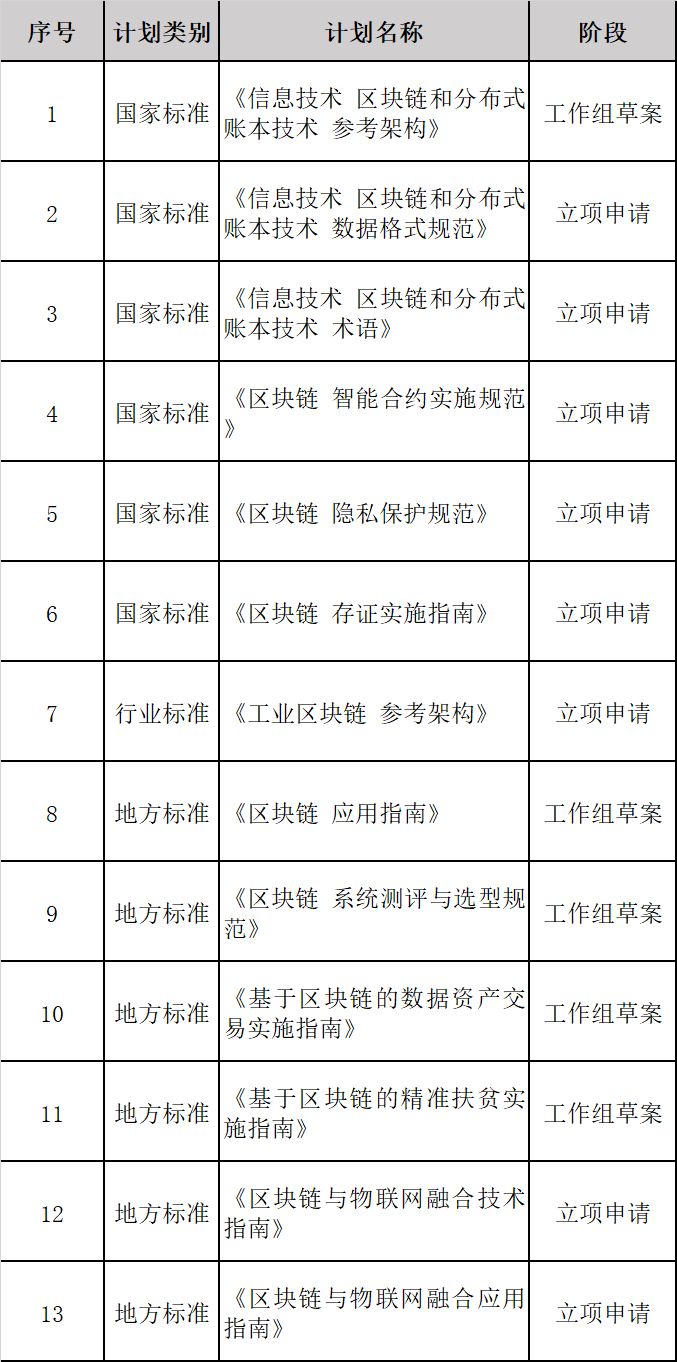
Table 2-4 Domestic Blockchain Standards
1.National standards
In December 2017, the National Information Standards Blockchain and Distributed Ledger Technology Reference Architecture (hereinafter referred to as the "Reference Architecture") national standard plan was approved for approval (plan number 20173824-T-469), China Institute of Electronic Standardization Organized more than 30 domestic enterprises to develop national standards. At present, the content of the standard has been improved according to the application of the "Blockchain Reference Architecture" group standard released in 2017, and an opinion draft has been formed.
The "Reference Architecture" national standard is an important basic standard in the field of blockchain. The standard gives important terms and definitions related to blockchain, and specifies the reference architecture, typical characteristics and deployment mode of blockchain and distributed ledger technology. Describes the blockchain ecosystem, which has important guiding significance for the selection and application of blockchain services in various industries and the construction of blockchain systems.
Industry standards
Blockchain has great application potential in the industrial field. Its key features such as distributed peer-to-peer, transparent and reliable, and high reliability are important to improve industrial production efficiency, reduce costs, improve industrial system security and reliability, and improve supply chain collaboration. Level and efficiency, as well as promoting management and business innovation, have a role that cannot be ignored.
At this stage, the application for the industrial standard of the Industrial Blockchain Reference Architecture has been completed. This standard aims to provide a basic system framework for the application of the blockchain in the industrial field. The issue of planning, building, and using blockchain products and services; on the other hand, providing the application, data and technical framework content of industrial blockchain to help improve the quality and level of industrial blockchain projects.
The standard will help improve the consistency and interoperability of the blockchain applications in different industrial fields, and provide support for the industrial blockchain ecological construction. At the same time, it provides guidance for the organization's internal industrial blockchain platform and system construction, and also provides an important basis for the development and delivery of the organization's products and services provided by the industrial blockchain.
3. Local standards
In August 2017, in order to promote the common development of the political, civilian, and commercial blockchain of Guizhou Province and the construction of a support system, it was initiated by the Big Data Development Administration of Guizhou Province, the People's Government of Guiyang City, and the China Electronics Standardization Research Institute. Guizhou Province Blockchain Standard Construction Guidance and Coordination Group and Guizhou Province Blockchain Standards Working Group officially launched the development of Guizhou Province blockchain standards.
Local standards in Guizhou province under development include "Blockchain Application Guide", "Blockchain System Evaluation and Selection Specifications", "Blockchain-based Precision Poverty Alleviation Implementation Guide" and "Blockchain-based Data Asset Transaction Implementation" Guide, which is expected to be released before 2020.
In January 2019, Wuxi National Hi-Tech Industrial Development Zone started the development of two local standards, the "Blockchain and Internet Fusion Technology Guide" and the "Blockchain and Internet of Things Fusion Application Guide", which are expected to be released before 2020.
4, group standards
In order to effectively implement the requirements of the Letter on Entrusting the Study of Blockchain Technology and Application Development Trends (Ministry of Industry and Information Technology No. [2016] No. 840) of the Ministry of Industry and Information Technology's Information Technology and Software Services Industry Department, China's Blockchain Technology And Industry Development Forum (hereinafter referred to as: the Forum) was established in Beijing on October 18, 2016.
The forum was guided by the Ministry of Industry and Information Technology and Software Services Industry Department and the National Standards Committee Industrial Standards Department 2. The China Electronics Technology Standardization Research Institute combined with Wanxiang Blockchain, Ant Financial, Weizhong Bank, Ping An Group, Zhongan Technology, and Anni Shares The composition of key domestic enterprises and institutions engaged in blockchain, such as Yi Jian shares.
Since the establishment of the forum, it has actively carried out standardization research and development, and has successively released the "Blockchain Reference Architecture", "Blockchain Data Format Specification", "Blockchain Smart Contract Implementation Specification", "Blockchain Privacy Protection Specification" and The 5 community standards in the "Blockchain Certificate Application Guide" (see Table 2-5) are providing a basis for the development of domestic blockchain applications.

Table 2-5 Group standards of China Blockchain Technology and Industry Development Forum
Development Trends and Problems of Domestic Standardization
In June 2018, the Ministry of Industry and Information Technology announced the “ National Blockchain and Distributed Accounting Technology Standardization Technical Committee Preparation Plan Public Notice '', which proposed five types of standards: basic, business and application, processes and methods, credibility and interoperability, and information security. (See Figure 2-3), and tentatively clarified the 21 key blockchain standardization priorities and the national standard system table of blockchain and distributed ledger technology in the future.
Basic standards are used to unify blockchain terminology, related concepts and models, and provide support for the formulation of other parts of the standard; business and application standards are used to regulate the design, deployment, and delivery of blockchain application development and blockchain application services, And transactions based on distributed ledgers; process and method standards are used to regulate the updating and maintenance of blockchains, and guide the implementation of communication and data exchange between different blockchains; credible and interoperable standards are used to guide blockchain development platforms Construction, standardize and guide the development of blockchain-related software, and achieve the interoperability of different blockchains; information security standards are used to guide the implementation of blockchain privacy and security, and identity authentication.

While actively promoting standardization, we should also realize that there is still a lot of room for improvement in blockchain standardization. The industry is facing problems such as the imperfect standard system, the slow progress of standards, the low degree of application of technology, and the inability to effectively unify and coordinate. .
1. The standard system is not yet complete.
Most of the standardization work in the domestic blockchain field is focused on the research of basic standards, such as "Blockchain Reference Architecture". Process and method standards are still in the blank stage, and standardization research in four directions of cross-chain communication mechanism, cross-chain communication message specification, ledger management specification, and consensus mechanism has not yet been carried out. How to guide and regulate the update and maintenance of the blockchain, and the communication and data exchange between different blockchains need to be urgently resolved.
2. The degree of application of blockchain technology is low.
The degree of application of standards directly reflects the degree of market, economic and social demand for standards. The contradiction between the financial attributes of blockchain and regulatory requirements and the unclear profit model of blockchain applications have severely hindered the development of blockchain technology. At the same time, application services based on blockchain technology cannot establish an effective profit model. There are still problems such as unclear business ideas, uncertain profit models, and conceptual hype, which have caused integrators to maintain a conservative attitude towards blockchain applications.
3. The development of standards is slow.
As mentioned in the "Reform Plan for Deepening Standardization Work" [3] issued by the State Council in 2015, China's national standard-setting cycle averages three years, far behind the needs of rapid industrial development. Standards are updated slowly, and the "standard age" is more than double that of developed countries such as Germany, the United States, Britain, and Japan. At the same time, blockchain technology is at an early stage, and the 3-year release cycle may cause issues that are outdated and cannot meet the needs of industrial development.
4. Lack of a unified coordination mechanism.
Compared with national standards and industry standards, there are relatively many standards related to blockchain, and the lack of a unified coordination mechanism is not conducive to the establishment of a unified ecosystem. According to the "Standardization Law of the People's Republic of China", the National Standardization Administration Committee and the Ministry of Civil Affairs have formulated the "Regulations for the Management of Group Standards" (hereinafter referred to as the "Regulations") [4].
The "Regulations" stated that group standards are standards established by social groups established in accordance with the law in order to meet market and innovation needs and coordinate with relevant market entities. Group standards are the basis for the production and management activities of social groups. They should enhance unity and authority, and reduce cross-repetitions, duplications, and conflicts among group standards.
Standardization recommendations
Strengthen awareness and unification
For a long time, standardization has focused on the development process of standards, and has not paid attention to the implementation process of standards. The standards that have been formulated cannot exert their true value, which directly leads to derailment of standards and practices. Standard promotion activities are not only a continuation of standard setting work, but also the prerequisites and basic work for the smooth implementation of standards. It is an important content of standardization activities.
Blockchain technology is in the early stages of development. The understanding of blockchain in different industries understands its meaning from different levels and from different perspectives. At this stage, the role of standardization work should be based on the nature of blockchain technology, strengthen the promotion of standards, unify understanding from the technical, application, economic and other levels, clear the original, and guide the orderly and standardized development of the industry.
Focus on coordination between standards
Standards have a variety of standards from international standards, national standards, industry standards to local standards, corporate standards, and enterprise standards. International standards are the product of coordination among countries, and to some extent reflect international consensus.
Conscientiously studying and promoting international standards, and making China's standardization system compatible with international standards, is the best way to enhance China's technological competitiveness and improve its advanced technology. National standards provide the most basic rules for various industries. Industry standards and local standards are useful supplements to national standards, and enterprise standards are specific requirements within the enterprise. Group standards have obvious applicability within the scope of specific groups, can effectively supplement the gaps in standards at different levels, and are a way to quickly transform technology into application results.
Therefore, the standardization work in the blockchain field should pay attention to the coordination and supplement of standards at different levels, and encourage the coordinated development of standards.
Urgent use first, iterative update
Blockchain technology has developed rapidly and has different understanding and understanding of it at each stage. The role of standardization is only the unification and consensus at the current stage. It should be updated iteratively as technology develops.
In terms of standard development, it is carried out in accordance with the principle of "emergency first, maturity first". At the same time as the development of basic standards, standards in the fields of application and security can be developed simultaneously, as soon as possible, the gaps in the practice of related standards can be broken as soon as possible, and the construction of a blockchain standard system can be improved.
Strengthen the combination of standards and industry
Standardization is a process of summarizing and refining scientific, technical, and empirical results in various fields. No matter what type of standard is, the purpose is to "for the best order within a certain range" and "to promote the best Co-benefits. "
Standardization and the development of the industry are complementary and mutually reinforcing. Standards are a powerful basis for the transformation of technology into productivity. Technology is transformed into productivity through standardized means, thereby promoting the progress of the entire industry. With the development of technology, blockchain will become the infrastructure for building rich application scenarios in different fields for some time to come. Therefore, the formulation of blockchain standards should also consider the interconnection between different fields, and also take into account different fields. Specific needs.
Industry Status
Blockchain has technical features such as trustworthiness, consensus, and tamper resistance. It is more suitable for applications that lack trust, and can provide effective technical means for enterprises to expand the ecological environment and supply chain in the Internet environment. In the future, the blockchain will be integrated with the application scenario like the IT industry, becoming a technical guarantee for value transfer and exchange, and a necessary infrastructure for the development of all industries.
Key technology
Blockchain technology includes important key technical components such as peer-to-peer communication, distributed storage, encryption algorithms, consensus mechanisms, incentive mechanisms, and smart contracts. These technical components have been fully introduced and discussed in most books and literature. From the perspective of standardization, more attention should be paid to technologies that can quickly promote industrial development. Blockchain-related cross-chain technology, "on-chain" technology, distributed storage technology, and component technology will affect the development process of the blockchain industry.
1.Cross-chain technology
The biggest problem of the traditional information Internet is the "information island". Currently, there are thousands of blockchain platforms distributed globally, and each blockchain platform is an independent, vertical and closed system. While we have not completely solved the problem of information silos, we have also established silos of value. Through technological innovation to realize the interconnection and interconnection between blockchain platforms, the realization of inter-chain value flow has become an important issue in the development of current blockchains.
Cross-chain technology will be the key technology for building a value Internet. Only by breaking through cross-chain technology can a single blockchain platform be truly connected to the network. The network effect is used to bring the value of the blockchain technology to stimulate the exchange and transfer.
2. "On-chain" technology
The "assets" carried by mainstream blockchain platforms such as Bitcoin and Ethereum are native "digital assets" in the digital environment, and there is no solution to the process of physical asset chaining and trading or exchange. Native "digital assets" have no value anchoring, so they can easily generate huge fluctuations.
Physical assets in the physical environment (such as artworks, land, real estate, etc.) have real value and exchange demands, but need to use specific technologies to associate substances with different physical attributes with the "assets" on the chain. This process requires the application of related technologies such as the Internet of Things, physics, and biological engineering to identify the unique attributes of physical assets. For example, NFC chips, DNA, and spectral analysis are used to map physical assets such as luxury goods, art, and alcohol to the digital environment. In this way, physical assets are associated with "digital assets", which supports applications such as certificate storage, traceability, and exchange. Only by “on-chain” physical assets can the value carried by the blockchain technology be scaled up and the development of the blockchain industry be accelerated.
3.Component technology
Component technology is a technology in software engineering, which can greatly reduce the development cycle and cost, improve the quality of software systems, and component technology represents the maturity of the development of an industry.
Blockchain technology is in the early stages of development. Each system needs to develop technologies or functional components such as identity recognition, smart contracts, consensus mechanisms, and encryption mechanisms. If common technical elements are decoupled, a technology set with independent functions will be developed. Packaging into commercial components and using middleware to develop a blockchain system will save more than half of the time and cost than direct development, and will greatly reduce the requirements for developers.
In the process of building components, you can try to encapsulate key technical capabilities such as smart contracts, consensus mechanisms, and KYC into middleware to provide middleware-based products or services to the industry, which can greatly reduce the industry threshold and allow more companies to quickly The development of blockchain applications promotes the landing of blockchain applications and accelerates the development of the blockchain industry.
4.Distributed storage
Due to the characteristics of blockchain technology, the blockchain database records every transaction, and each consensus node must store and update all block data in real time. The ledger stored by the consensus nodes of the Bitcoin network has reached more than 170G, which will bring huge storage, bandwidth and computing costs to the consensus nodes. Expensive costs will reduce the willingness to participate in the consensus nodes. The reduction of the consensus nodes will affect the system. Equilibrium, forming a consensus of a few people, will eventually run counter to the idea of "decentralization" of blockchain technology.
Therefore, related issues such as distributed storage have become the bottleneck of industrial development, and more research and practice are needed.
Open source platform
1. Foreign open source projects
At present, the underlying blockchain platforms that have received much attention and are widely used in foreign markets include Ethereum and Hyperledger Fabric. Among them, the Ethereum Project was launched by the Ethereum Foundation in 2013. It is a complete one-stop development platform for Turing. It has a relatively complete technical ecosystem, and a variety of DAPPs have been running on the Ethereum network.
Hyperledger (Super Ledger) is initiated by the Linux Foundation and currently incubates a number of open source projects including Fabric, Iroha, Sawtooth. Among them, Fabric is a blockchain implementation solution with a structure that can be inserted into various functional modules, and the system is layered. The design is relatively reasonable, and the degree of modularization is gradually improving. It is one of the choices for large enterprises to build the bottom layer of the blockchain.
2.Domestic open source projects
The representative open source community in China is the distributed application ledger (DAppLedger) open source community initiated by the China Blockchain Technology and Industry Development Forum in December 2017. This community is based on the underlying platform independently developed by members of the China Blockchain Technology and Industry Development Forum, and gradually establishes a multi-platform operating model, explores the optimal architecture in the application integration process, and provides support for the development of domestic blockchain applications.
Among the key open source projects are BCOS and Annchain. BCOS is jointly developed and maintained by Weizhong Bank, Wanxiang Blockchain, and Matrix Elements. On this basis, the open source working group of the Financial Blockchain Cooperation Alliance (referred to as: Golden Chain Alliance) focuses on the needs of the financial industry and further develops in-depth customization FISCO BCOS, BCOS and FISCOBCOS are all open source.
Annchain is an enterprise-level blockchain platform independently developed by ZhongAn Technology.The platform has strong scalability, and at the same time adopts the method of transaction as consensus, which can effectively improve efficiency and allow transactions to be concurrent. It can provide rapid chain deployment, middleware, Support tools or products such as audit browsing and system monitoring.
Application practice
Blockchain technology can reduce business friction and improve collaboration efficiency in the multi-party collaboration process. However, the difficulty of truly reorganizing or innovating the business ecosystem based on blockchain technology is not a technical issue. Technology is only to complete the construction of the underlying platform and applications. The focus is on the integration of the business ecosystem.
From the perspective of application innovation, two aspects can be considered. First, can a new business scenario be constructed based on the technical characteristics of the blockchain. For example, blockchain technology can be used in the supply chain field to take advantage of technical features such as trustworthiness, consensus, and tamper resistance to create new Internet financial application scenarios. Ruzhong step by step chicken project. Second, to solve problems that cannot be solved by certain types of traditional Internet. For example, due to its high value and complex industrial chain, the field of art is not covered by the traditional Internet field, and the technical characteristics of the blockchain just solve the problem of high-value asset transfer.
With the rapid development of blockchain technology, more and more fields use blockchain technology to solve the problem of trust. There are endless applications for industries such as finance, education, supply chain, logistics, and agriculture. classification.
However, from the perspective of the technical characteristics of the blockchain, the certification of education in the education field and the traceability of the agricultural field are the application of the existence proof based on the tamper-resistant characteristics of the blockchain technology. Therefore, it can be explored to divide the application of blockchain into four categories: deposit and confirmation, transaction or exchange, asset securitization, and traceability (see Figure 3-1).
1. Deposit and confirmation
Provide related services such as property rights or property rights registration for assets through certificate and confirmation of assets. Such as art or digital music depository services.
2.Transaction or exchange
Provide services for the transaction or exchange of assets on the basis of clear property rights or property rights. Such as the sale or transfer of art.
3.Financialization of assets
On the basis of clear property rights or property rights, assets are mortgaged or related financial derivatives such as ABS are issued to release the potential value of assets without transferring property rights. Services such as mortgages for artworks.
4. Recording the asset deposit certificate, transaction or exchange on the blockchain can provide support for the traceability of the asset life cycle. Such as artwork and traceability.
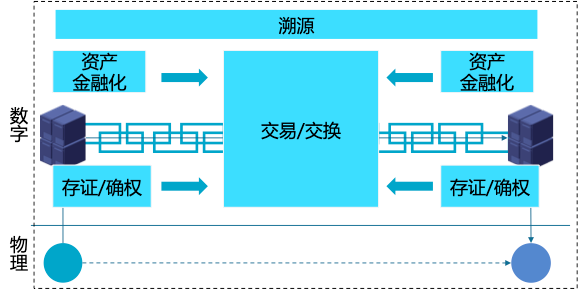
Industry recommendations
With the development of blockchain technology, its technical advantages have been gradually tapped and recognized. In order to accelerate the service of technology to the real economy, it is necessary for all sectors of the society such as government, industry, academia, research, consumption and capital to work together to promote the industrial development based on blockchain technology.
1. Cultivate business cooperation models of research, technology, application and capital integration.
The blockchain industry is still at a very early stage, with insufficient research depth, imperfect technology platforms, unclear application requirements, and unfounded capital investment. It is difficult for any interested party to have the ability to research key technologies, build a technical platform, design application models, and sufficient capital at the same time. Therefore, it is necessary to analyze the needs of various interested parties, integrate the resources of all involved parties, and jointly establish a collaborative business model to accelerate the application practice Iterate, establish a sound industrial ecology and clusters, and jointly promote industrial development.
2. Encourage large enterprises with their own ecology and traffic to apply blockchain technology.
Generally speaking, large enterprises often have mature business models, rich business scenarios and large-scale customer groups, which have more advantages in driving the development of blockchain.
First, large enterprises usually occupy more ecological resources in related industries, have stronger industry competitiveness, and can invest more resources in emerging technology fields. Secondly, the strategic layout of large enterprises with their own traffic can usually affect and drive the business direction of upstream and downstream small and medium-sized enterprises. It can quickly integrate the advantages of new technologies into the existing ecosystem, which has a greater driving force and leading role for the industry.
3. Accelerate the construction of an industrial service platform that integrates technology and application service platforms.
With the innovative exploration and application of blockchain technology in various industries, more companies have increased their investment and financing of blockchain, developed supporting personnel training systems, and held a series of innovative activities such as development competitions to serve the blockchain. Industrial Development.
Since the establishment of the China Blockchain Technology and Industry Development Forum in October 2016, in terms of technology, it has actively carried out basic research and standardization of key blockchain technology, established a test evaluation system to provide test services, and promoted the establishment of a Chinese independent open source community. The blockchain technology platform provides support for the implementation of blockchain application scenarios.
In terms of applications, it actively develops blockchain development competitions to foster application landing, develops supporting talent training systems to accelerate application research, and gradually forms a complete blockchain industry service platform, and makes a positive contribution to building a blockchain industry development ecology.
Thinking
Systems engineering
In the process of applying blockchain technology, we should follow the idea of system engineering and design the process of application practice from the three dimensions of knowledge, logic and time (see Figure 4-1).
First, the knowledge elements in the knowledge dimension should be clarified. The China Blockchain Technology and Industry Development Forum released the "Blockchain Reference Architecture" in 2017, which gives a functional view of the blockchain. The functional view shows what the blockchain technology should include. Technology components. Second, the logical implementation path should be established in the logical dimension, and the value, application, scenario, technology, and platform selection should be completed, and the logical implementation process should be designed and executed. Finally, a clear time plan should be formulated according to the requirements, and the blockchain system construction and operation services should be gradually realized in strict accordance with the planned mileage card.
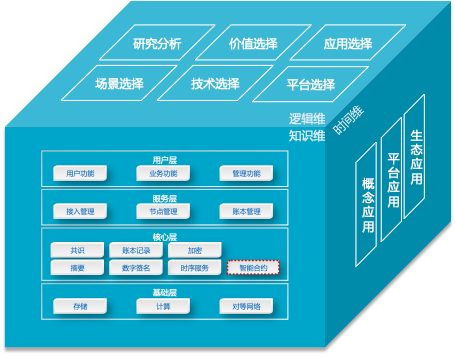
Technology fusion
Blockchain and next-generation information technologies such as cloud computing, big data, the Internet of Things, communication technology, and artificial intelligence are not isolated from each other, but are interrelated (see Figure 4-2). The emergence of each technology has its own development law, all need to rely on the development of pre-techniques to promote the construction of a technical system.
The development of the entire technology system has a clear logical relationship. The maturity of the Internet of Things technology has gained more data. The development of communication technology has accelerated the flow of data. The development of cloud computing technology has made it possible to carry data and schedule resources. Accelerates data processing capabilities, and artificial intelligence enables data utilization. In the process, the new generation of information technology is converging and applied to promote the maximum value of data.
Therefore, higher requirements are imposed on the quality of the data. Blockchain technology with credibility, consensus, and tamper-resistant characteristics fills the final puzzle and provides technical guarantee for maximizing the value of the data.
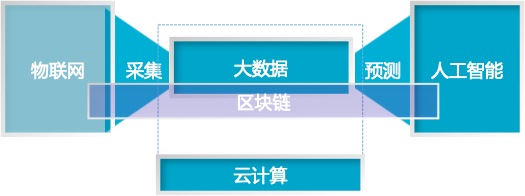
Component iteration
Blockchain is composed of encryption algorithm, consensus mechanism, distributed storage, point-to-point communication and other technologies, providing trustworthy, consensus and tamper-proof technical guarantee. Blockchain and artificial intelligence, big data, cloud computing, Internet of Things and other technologies constitute a new generation of information technology to achieve the goal of maximizing the value of data. From the perspective of the development of the technology system, the new generation of information technology will build "future technology" with quantum computing, bioengineering and other technologies to accomplish larger goals (see Figure 4-3). Therefore, the blockchain can be regarded as a technical component in the technical system. While using its technical characteristics to achieve specific functions, it can be iteratively developed with other technologies to promote the progress of the technical system.
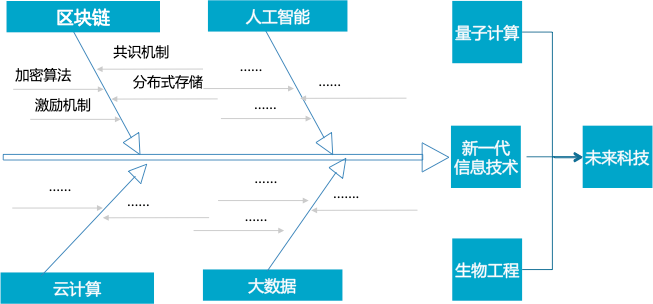
Destination system
From a system perspective, any technology has a purpose from its generation, development, and wide application. It needs different or combined technical means to achieve the desired result of the purpose.
In this process, you need to think according to a specific purpose, find the key elements to solve the problem, and build the system after the key elements are formed into components. The integration of technology in the system will provide services for different applications. The technology integration supporting the application is decoupled and encapsulated to serve the new technology and application system, and then build a complete ecology and industry with the new technology, and finally achieve the set goals (see Figure 4-4).
For example, in the development process of the blockchain, from the purpose of "decentralization", distributed thinking, integration and integration of multiple technologies to the Bitcoin network is a free-growing process, from blockchain technology, providing traceability applications to The realization of component engineering is a standardized process. It is an industrialization process from supporting the supply chain system and establishing a distributed consensus ecology to serving the digital economy industry. Throughout the development process, technology is used to accomplish the goal from the result to the expectation.
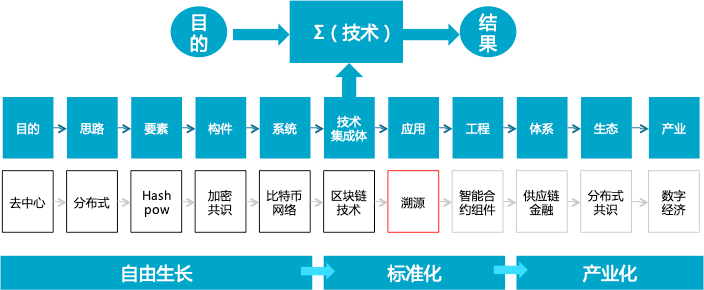
Figure 4-4 Purpose system
references
[1] GB / T 5271.1-2000 Information technology vocabulary Part 1: Basic terms [S]
[2] GB ∕ T 34960.3-2017 Information Technology Service Governance Part III: Performance Evaluation [S]
[3] ISO / IEC TR 38505-2 InformationTechnology — Governance of IT — Governance of data — Part 2: Theimplications of ISO / IEC 38505-1 for data management [S]
[4] Ming Ming, Research on IT Governance Standards [J] Information Technology and Standardization, 2016 (3): 29-33
[5] Li Ming, Research on IT Governance Standard Industry [J] Information Technology and Standardization, 2016 (7): 26-28
[6] Ming Ming, Research on International Standards for Data Governance [J] Information Technology and Standardization, 2016 (10): 23-26.
[7] (US) Brian Arthur, The Nature of Technology [M], Translated by Cao Dongsun / Wang Jian, Zhejiang People's Publishing House, 2014
We will continue to update Blocking; if you have any questions or suggestions, please contact us!
Was this article helpful?
93 out of 132 found this helpful
Related articles
- Hawaii, U.S. establishes regulatory sandbox for digital currency companies, issuers can conduct business without license
- Viewpoint | Blockchain + Education Scenario Analysis: What kind of "evaluation" requires a blockchain?
- Babbitt Column | How to use options to motivate cryptocurrency developers? Take BCH as an example
- Russia's central bank director of legal affairs: "there is more than enough" to ban Bitcoin
- Research Report | The average return of cryptocurrencies in 2019 is far less than that of traditional financial markets, and the risk is more than 5 times that of traditional financial markets
- The South Korean government again allocated 3.9 billion won to support the development of the blockchain, looking for 9 small and medium-sized blockchain companies
- Opinion | Why use blockchain technology to improve the national infectious disease surveillance and early warning system?





